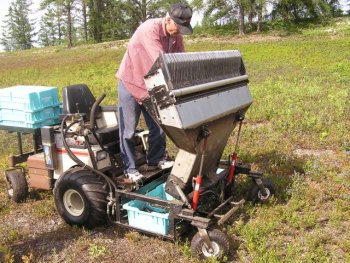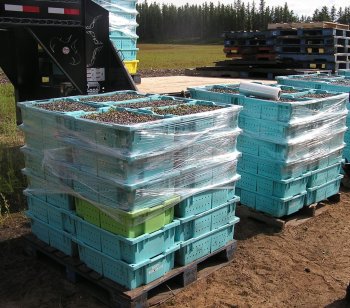
A berry with Moundridge connections
Dec 9, 2010
The next time you come across blueberries in the supermarket, look to see if theyre from Canada. If so, theres a chance the berries were harvested with the help of a Grasshopper. The blueberries around Lac Saint-Jean in Quebec, Canada, are wild varieties that grow naturally throughout the region. When the area was cleared and cultivated for farming in the 1800s, the blueberries proved quite hardy, spreading prolifically by underground root systems. Wild blueberries are generally regarded to be more nutritious than domesticated varieties, high in antioxidants and beneficial to the digestive system. The plants grow naturally into bushes, but Lac Saint-Jean farmers discovered that mowing the plants low to the ground every other year significantly increased yields. After the blueberry fields are mowed, they are allowed to lie fallow for one season and are harvested the next. A narrow window of opportunity exists to harvest ripe blueberries: they ripen in mid- to late-July, and the first frost follows four to six weeks later. Any berries in the field after the frost are damaged. A farmer might need up to 50 family members or hired workers to harvest berries from a 5- to 20-acre field by hand. To make harvesting more efficient, one farmer has invented custom blueberry pickers attached to a FrontMount Grasshopper mower. With the custom pickers, the farm can now harvest most of the berries within that narrow window of time without hired hands. Albanel, Quebec, blueberry farmer Marc André Dumais owns two Model 618 and three Model 620 Grasshoppers. Mostly, they are put to work only one month a year, but more than pay for themselves in a single season. The special picker is fitted in place of the out-front mowing deck and allows each machine to gather up to 12,000 pounds of berries a day, more than 12 times the number of pounds a good hand harvester could gather in one day. Dumais says that Grasshoppers are the eighth wonder of the world, and have transformed his fledgling farm into a profitable, productive enterprise. The maneuverability, dependability and minimal maintenance of the Grasshoppers inspired him to create a fleet of picking machines. Each picker is designed with row of long, thinly spaced metal fingers that comb through the blueberry plants, stripping the stems of the berries which, when ripe, fall off the vine with little effort. A box at the base of the fingers collects berries, while a hydraulic lift raises the front end of the picker off the ground and dumps the berries into special bins positioned near the operators footrest. When the bins are full, the operator exchanges the full bins for empty ones. As with mowing, visibility is key to productivity in blueberry harvesting. The original Grasshopper dual swing-out control levers design provides unrestricted visibility for the operator and easy access to the bins without having to dismount the mower. Blueberry production around Lac Saint-Jean is poised for growth over the next several years. Gerard Baril, president of the Quebec Blueberry Growers Association, says demand for the berries in Asian and European markets is drawing more farmers around Lac Saint-Jean into blueberry production. While most of the berries go straight to the processing centers where they are cleaned and frozen for shipment worldwide, local producers of candies, jellies and blueberry-flavored foods and drinks are prolific in the small towns around Lac Saint-Jean providing unique gourmet delicacies for tourists and residents.
Download PDF Marc_Andre_Dumais_User Story.pdf

